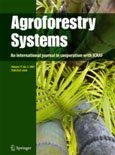Since forestry is often allocated to soils with a low weathering capacity, reliable estimates of weathering rates are crucial in analyses of sustainability, e.g. of whole-tree and stump harvesting. In the present study, weathering rates (kg ha1 yr1) for base cations were estimated using cation budgets in a replicated (n = 4) experimental Norway spruce (Picea abies (L.) Karst.) plantation situated on a nutrient-poor glacial till in south-west Sweden and aged 25–39 years during the study period. Weathering rates (central values) were 2.4, 1.4, 0.3 and 2.3 kg ha1 yr1 for Ca, Mg, K and Na, respectively. However, weathering was a minor flux in the overall cycling of these cations in the ecosystem, and the confidence intervals of the weathering estimates had amplitudes that generally were greater than the central values. The overall uncertainties were divided into (i) regular standard errors of the mean, expressing spatial variability, sampling errors and random method-related errors in data from measurements replicated over the experimental plots (‘Type A’ uncertainties), and (ii) estimated standard uncertainties accounting for systematic errors of methods, and of uncertainties in variables, functions and factors not replicated over the plots (‘Type B’ uncertainties). For Ca and K, bioaccumulation dominated the overall uncertainty. Most (>90 %) of this uncertainty, in turn, was of Type A (between-plot variability in measured stem diameters and cation concentrations); the remainder resulted from Type B uncertainties in allometric functions etc. Hence, regular standard errors over plots yielded a correct level of uncertainty of weathering estimates for these ions at the studied site. For Mg and Na, however, deposition and leaching were large terms in the cation budget. Whereas the uncertainty in deposition was mostly taken into account by plot-wise replicated measurements of throughfall (Type A uncertainty), Type B uncertainties were crucial to the estimates of leaching. Due to the fact that uncertainties accumulate when terms are added and subtracted in a cation budget, it is difficult to predict the sustainability of the pools of exchangeable cations from estimated weathering rates; it may be better to measure them directly in the soil. However, in the studied ecosystem these had a rapid turnover (mean residence time, 1–4 years), and underwent abrupt fluctuations over only a few years. A study performed during a limited time may therefore suffer from considerable temporal uncertainties, if the results are to be generalised for a longer period.
DOI:
https://doi.org/10.1016/j.foreco.2014.12.024
Altmetric score:
Dimensions Citation Count:
























